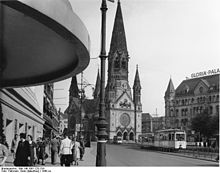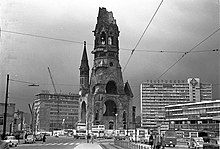Breitscheidplatz
Breitscheidplatz | |
|---|---|
Zoofenster an Bikini-Haus in 2016 | |
| Country | Germany |
| City | Berlin |
| Historical features | Charlottenburg Kurfürstendamm Kaiser Wilhelm Memorial Church |
Breitscheidplatz (German pronunciation: [bʁaɪtʃaɪtˌplats] ) is a major public square in the inner city of Berlin, Germany. Together with the Kurfürstendamm boulevard, it marks the centre of former West Berlin and the present-day City West. It is named after Rudolf Breitscheid.
Location
Breitscheidplatz lies within the
History
Breitscheidplatz is at the end of the former Kurfürstendamm bridle path of 1542 which led
Shortly after the square was laid out, Auguste-Viktoria's spouse Emperor
20th century

After World War I, the square became a meeting place for
In 1943, the square was heavily bombed and most of the area was destroyed. After World War II the square experienced massive reconstruction when it became the quasi-symbolic centre of West Berlin in compensation for the loss of the historic centre around Alexanderplatz and Unter den Linden in Mitte, then part of East Berlin. In 1947 the square was given the new name 'Breitscheidplatz' after Rudolf Breitscheid, a German Social Democrat who was killed at the Buchenwald concentration camp in 1944.
Post-war

The Kaiser Wilhelm Memorial Church (informally known as der Hohle Zahn, "the Hollow Tooth", by Berliners) was in shambles after the war. In the 1950s and 1960s the trend in Berlin was to tear down buildings damaged in the war and to build anew. The renowned West German architect
The development of the square included the erection of the
In 1965, the Europa-Center shopping mall was opened by Mayor Willy Brandt on the site of the former Romanisches Café. It included a large cinema complex and an 86 m (282 ft) highrise. The Center with its characteristic Mercedes-Benz star on top became a major business centre and unofficially gave the Breitscheidplatz the reputation of being the commercial hotspot in West Berlin. Today the building still hosts numerous department stores, pavement coffee shops and restaurants and is a popular tourist attraction. It has landmark status.
Redevelopment

The Breitscheidplatz, still one of Berlin's most visited places, is known by many as one of the quintessential squares of Berlin. It presents an awkward yet typical Berlin combination of the old and the new, the cultural and commercial.
Since the turn of the millennium, city plans developed for the Breitscheidplatz[2] include bettering the quality for pedestrians and more public competitions for the future planning of Breitscheidplatz. In 2006, the automobile tunnel on Budapester Straße in front of the Bikini-Haus was closed and the pedestrian zone extended. From 2010 to 2014 the Bikini-Haus was refurbished as a shopping mall and a hotel, including the redevelopment of the adjacent Zoo Palast as a multi-screen cinema complex. The destruction of the Schimmelpfeng-Haus began in 2009 to build the 118 m (387 ft) Zoofenster highrise, with offices, restaurants and a Waldorf Astoria hotel, and the neighbouring Upper West tower block, to create an attractive urban area with livable space. Other plans include renovating the bus station on Hardenbergplatz in front of the Bahnhof Zoo and other urban spaces in the vicinity.
2016 Christmas market attack
On 19 December 2016, at about 20:00 local time, a truck-ramming attack was made on the Christmas market at Breitscheidplatz, killing thirteen people and injuring 48 others.[3][4]
In preparation for the Christmas market 2018, the square and its surrounding were fortified against further terrorist attacks.[5][6]
Public transport
Breitscheidplatz can be reached by
The Bahnhof Zoo was constructed in 1882 and functioned as the main railway station of West Berlin. Its importance as a major hub diminished when in preparation for the
See also
References
- ISBN 9780520222991, [ pp. 181–83].
- ^ See: Stadtentwicklung.Berlin.de
- ^ "Berlin lorry deaths: Police say 'probably terrorist attack'". BBC. 20 December 2016.
- ^ "Berlin attack: First aider dies 5 years after Christmas market murders". BBC. 26 October 2021. Retrieved 26 October 2021.
- ^ "Advent hinter Gitterkörben". www.rbb24.de (in German). Archived from the original on 28 July 2019. Retrieved 1 December 2018.
- ^ "Wie Berlins Weihnachtsmärkte ihre Besucher schützen". www.rbb24.de (in German). Archived from the original on 1 August 2019. Retrieved 1 December 2018.
Sources
- http://www.stadtentwicklung.berlin.de 18 May 2006
- Senatsverwaltung für Stadtentwicklung, Berlin (April 2004) "Nachhaltiges Berlin".
- Senatsverwaltung für Stadtentwicklung, Berlin (December 2005) "Stadtforum Berlin".
